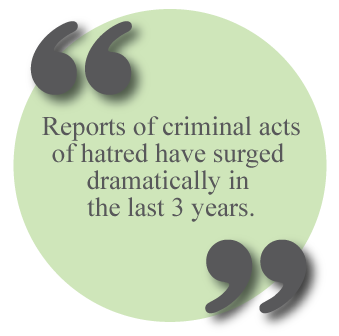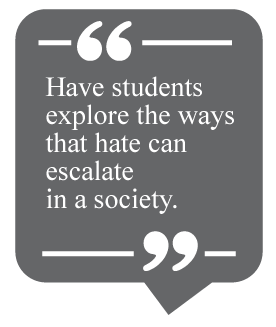Hate Crimes on the Rise: What Can Teachers Do?
by Rita Van Dyke-Kao
 Reports of criminal acts of hatred have surged dramatically in the last 3 years, both in the United States and in the international community. Focusing on the United States, the Federal Bureau of Investigation (FBI) and Bureau of Justice Statistics define a hate crime as “a committed criminal offense which is motivated, in whole or in part, by the offender’s bias(es) against a race, religion, disability, sexual orientation, ethnicity, gender, or gender identity.” Though the three most common offenses reported to the FBI are destruction/damage/vandalism, intimidation, and simple assault, other hate crimes include murder and human trafficking. The FBI’s most current hate crime report (2019) shows that there was a 17% uptick in hate crimes between 2017 and 2018. Racial hate crimes have remained the highest percentage of all hate crimes, and hate crimes based on religion and sexual orientation are seeing significant increases. The Southern Poverty Law Center (2019) closely monitors the activities of domestic hate groups in the United States, and their reporting indicates that there are a staggering 1,020 hate groups currently operating in the United States.
Reports of criminal acts of hatred have surged dramatically in the last 3 years, both in the United States and in the international community. Focusing on the United States, the Federal Bureau of Investigation (FBI) and Bureau of Justice Statistics define a hate crime as “a committed criminal offense which is motivated, in whole or in part, by the offender’s bias(es) against a race, religion, disability, sexual orientation, ethnicity, gender, or gender identity.” Though the three most common offenses reported to the FBI are destruction/damage/vandalism, intimidation, and simple assault, other hate crimes include murder and human trafficking. The FBI’s most current hate crime report (2019) shows that there was a 17% uptick in hate crimes between 2017 and 2018. Racial hate crimes have remained the highest percentage of all hate crimes, and hate crimes based on religion and sexual orientation are seeing significant increases. The Southern Poverty Law Center (2019) closely monitors the activities of domestic hate groups in the United States, and their reporting indicates that there are a staggering 1,020 hate groups currently operating in the United States.
In the face of such hate, what can TESOL professionals do to prepare and equip our English learners, particularly in the classroom? English language educators have a responsibility to address the issues that face our students. English language learners in the United States are at a higher risk of being a victim of a hate crime than other people in the United States, as these English learners often are non-White, belong to a religious community that is at a higher risk of being targeted, or stand out because of their lack of mainstream cultural and linguistic knowledge. Attempting to be neutral, or remaining silent, when issues of hate arise in the classroom is indefensible for educators who seek their learners’ well-being.

Here are some suggestions on how educators of English language learners can proactively address and prepare students for the troubling reality of hate crimes:
1. Ensure Students Know Their Rights
Inform students that if they have witnessed or been victimized by a hate crime, they can report the incident to the police. You can also encourage them to report the incident to ProPublica’s Documenting Hate website, which is a nonprofit investigative newsroom that tracks incidents of hate.
Incorporate project-based learning in your class by having students research a topic related to hate crimes and then present their findings to the class through a poster or multimedia presentation. For example, adult ESL students could research what to do if they experience sexual harassment at work, or what to do if they witness a hate crime. This project gives students the opportunity to discover resources and teach their classmates critical information on how to conduct themselves in a country and culture that may be new to them. Moreover, this knowledge empowers students who may have been victimized by acts of hate and discrimination.
2. Model Civic Responsibility Through Advocacy
Hate crimes are notoriously underreported, with many major American cities reporting no hate crime statistics whatsoever. For a country that purports to take public safety seriously, the lack of reliable data on hate crimes is deeply problematic. Data drives policy, and better data collection would result in allocation of funds toward protecting vulnerable communities. However, after the horrific murder of Heather Heyer by a White supremacist in Charlottesville, Virginia, in 2017, a bipartisan coalition in Congress is seeking to give law enforcement funding to improve hate crime reporting and expand support for victims of hate crimes.
The bill is named the Khalid Jabara-Heather Heyer National Opposition to Hate, Assault, and Threats to Equality Act (which goes by the acronym NO HATE). If you live in the United States, urge your congressperson and senators to support this bill. If you live in another country, advocate for hate crime reporting legislation in your own context.
Make this an opportunity to teach your students about the legislative process in your country, and have students participate in the democratic process of contacting elected officials through a persuasive letter writing project. Teaching students how to write a persuasive letter to an elected official is an authentic and powerful way to model civic responsibility to your students.
3. Introduce the Pyramid of Hate
 Hate crimes are the surface reality of deep, systemic issues. The Anti-Defamation League’s Pyramid of Hate (2018) is an impactful teaching tool that visually illustrates the effects and consequences of prejudice and bigotry.
Hate crimes are the surface reality of deep, systemic issues. The Anti-Defamation League’s Pyramid of Hate (2018) is an impactful teaching tool that visually illustrates the effects and consequences of prejudice and bigotry.
After discussing any unfamiliar vocabulary words used in the pyramid, have students explore the ways that hate can escalate in a society. Assign one level of the pyramid to a small group and have the students brainstorm examples from history, current events, or their personal experiences that demonstrate the behaviors in their assigned level.
4. Discuss Quotations
Compile a list of quotations from notable figures who have stood up against hate. Here are some example quotations:
“Darkness cannot drive darkness: only light can do that. Hate cannot drive out hate: only love can do that.”
– Martin Luther King, Jr.
“Hate, it has caused a lot of problems in the world, but it has not solved one yet.”
― Maya Angelou
“In the practice of tolerance, one’s enemy is the best teacher.”
– The Dalai Lama
“Misunderstanding…arising from ignorance breeds fear, and fear remains the greatest enemy of peace.”
– Lester B. Pearson
“No one is born hating another person because of the color of his skin or his background or his religion. People must learn to hate, and if they can learn to hate, they can be taught to love, for love comes more naturally to the human heart than its opposite.”
– Nelson Mandela
Ask students to discuss in small groups whether they agree or disagree with each quotation. Then have students search online to learn more about these figures who have fought against hate.
5. Host a Movie Night
Film is a powerful way to introduce the weighty issue of hate crimes into the classroom. The hate crime/genocide genre has many titles to consider, including
- Apt Pupil,
- School Ties,
- American History X,
- Mississippi Burning,
- Hotel Rwanda,
- The Killing Fields,
- Rabbit-Proof Fence, and
- Schindler’s List.
Before viewing the movie, introduce vocabulary and idioms to students, as well as historical background. After watching the movie, facilitate a discussion that addresses the hate crimes that are portrayed in the film.
References
Anti-Defamation League. (2018). Pyramid of hate. Retrieved from https://www.adl.org/sites/default/files/documents/pyramid-of-hate.pdf
BBC News. (2017). Charlottesville: Who was victim Heather Heyer? Retrieved from https://www.bbc.com/news/world-us-canada-40924922
Southern Poverty Law Center. (n.d.). Hate map. Retrieved from https://www.splcenter.org/hate-map
U.S. Department of Justice. (2019). Hate crime statistics. Retrieved from https://www.bjs.gov/content/pub/pdf/hcs1317pp.pdf
Rita Van Dyke-Kao is an assistant professor/coordinator of ESL in the Division of Continuing Education at Santiago Canyon College in Orange, California. Rita has taught in a number of different contexts, including teacher education in the United States; EFL in South Korea, China, and Burma; and ESL in community college and IEP contexts in Canada and the United States. She is passionate about both advocating for English language learners and teaching students how to advocate for themselves.